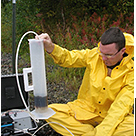Vapor Chemistry
Building Design Issues
| Data Analysis and Interpretation
Johnson and Ettinger Model
New Developments in Vapor Intrusion
|

More Information Directions Accommodations |
| ||||||||||||||||
|
Description: **Note - For every course we have implemented live stream remote attendance. You will need a computer and an internet connection. This course provides an overview of the vapor intrusion exposure pathway including its scientific foundation, regulatory framework, and the technical aspects of investigating and remediating contaminated vapor sites. The class will cover topics such as: screening sites for potential vapor intrusion concerns, conducting field investigations, sampling techniques, data analyses, exposure point calculations, the Johnson and Ettinger predictive model, vapor intrusion risk assessment, vapor intrusion mitigation, and remediation. Participants will work through practical problems and typical site scenarios based on case studies of established vapor intrusion sites. This course provides a comprehensive introduction for those new to the field, and will also provide insights, data analysis techniques, and the latest research for more advanced participants.
Intended Audience: Environmental professionals seeking an improved understanding of vapor migration and intrusion with an emphasis on vapor assessment and modeling. The material is intended for practitioners working on remediation of hazardous substance release sites and brownfields redevelopment. Continuing Education Units: 1.30 CEUs More InformationCourse Topics
About the InstructorElie H. Haddad
 Mr. Haddad is a vice president for Haley and Aldrich where he is involved in vapor intrusion investigations, remediation and modeling, risk assessments, planning and strategy, development and implementation of RI/FS programs, engineering designs, hydrogeological activities, computer modeling, and operation and maintenance programs. He led an unprecedented, and perhaps largest, indoor air investigation at a Superfund site. His work established a benchmark for other EPA sites. Mr. Haddad has used his skills to allocate remedial costs among potentially responsible parties at several sites, and to allow redevelopment of several contaminated properties into commercial uses. He supervised the development of remedial design for several Superfund sites, developed and used soil, groundwater, and air dispersion model, and is an expert in hydrogeological applications. Mr. Haddad is also a faculty member of the University of California at Berkeley Extension Program where he has taught the course "Fate and Transport of Contaminants in the Environment". In addition, Mr. Haddad serves on the seminar committee of the Groundwater Resources Association where he has chaired several seminars on various topics including vapor intrusion. What to BringA computer with an internet conneciton. You may want your text available or pencil and paper to take notes. Billing Information
In order to guarantee a space in a course, the tuition must be paid in full TWO WEEKS before the first day of the course by either check or credit card. State and government agencies paying with a purchase order are allowed payment under the two-week time frame if a copy of the purchase order is received by NWETC.
If You Need to CancelCancellations*
*Please note that attendee replacement is welcome at any time Disability AccommodationsDisability Accommodations:To request disability accommodations, please contact us at info@nwetc.org or 425-270-3274 at least 30 days prior to the event. |
|||||||||||||||||
Click the date of the course you would like to register for
*Reduced tuition available to employees of Native American tribes, nonprofits, and government agencies; students; and NAEP members.
If you have any trouble registering please call (425) 270-3274 ext 103
Please wait to receive a course confirmation email, roughly one month prior to the class, before making any travel arrangements. Please review what to bring!
© 2026 NWETC. All rights reserved